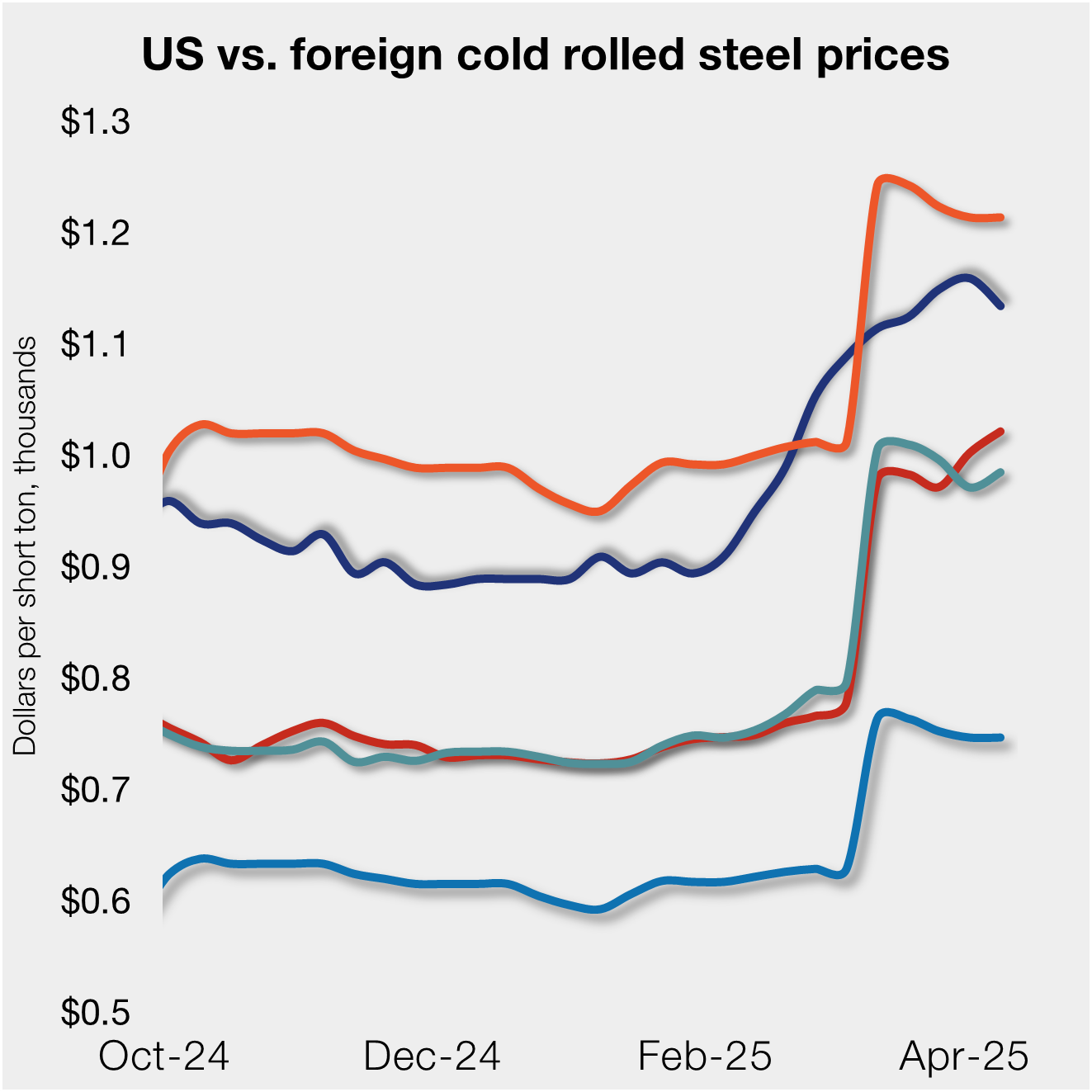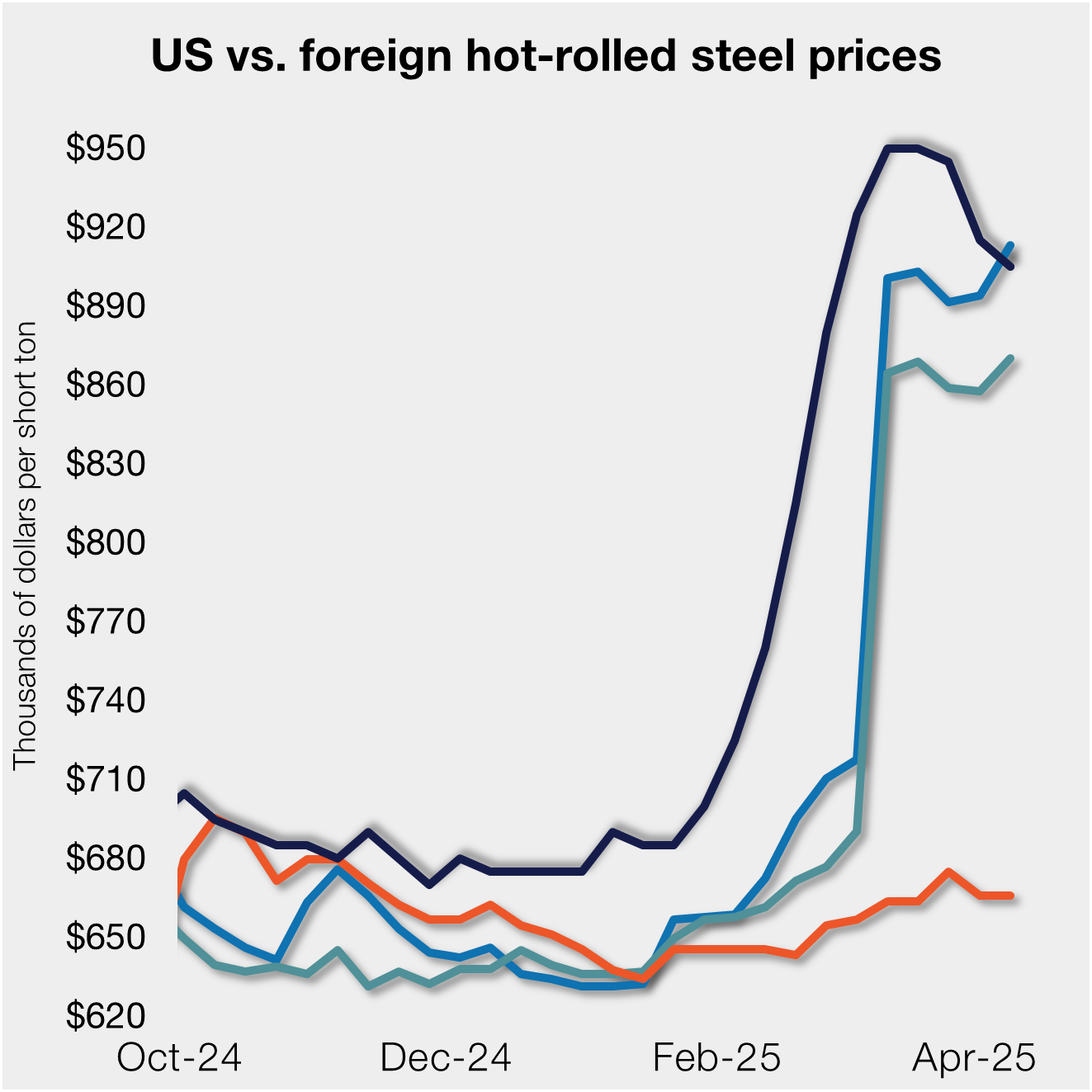Steel Products

Consensus View: Ferrous Scrap Prices Under Pressure for May
Written by Tim Triplett
March 28, 2019
Finished steel price momentum has been particularly difficult to gauge of late and what happens to ferrous scrap prices next month may be telling. Scrap for May appears to be under pressure.
Despite relatively healthy U.S. steel demand and domestic mills cranking out flat rolled steel at nearly full capacity, scrap prices have seen declines in three of the first four months of 2019. The benchmark price for hot rolled steel has slid to around $675 from $730 per ton at the beginning of the year.
While it’s a bit early to predict where scrap prices will settle in May, CRU North America Analyst Ryan McKinley would not be surprised to see scrap down another $10-20/GT. “However, if finished steel prices rise or there’s a major take-off in the export market, scrap prices could go sideways.” (For more on CRU’s view of the scrap export market, see “CRU: Scrap Price Falls Aided by Improved Supply” also in this issue.)
Steel prices have declined recently because of weaker-than-expected demand, particularly in the construction sector, McKinley noted. Should construction demand pick up as it typically does this time of year, another dip for scrap could have a minimal effect on finished steel prices. “Scrap prices are under pressure on the supply side of the equation, not the demand side,” he said. “Just look at how high the capacity utilization rates are right now.”
Assuming various mills complete their maintenance outages this month, scrap demand could pick up in May. “There was also some scrap overhanging the market in some regions, so the ability of dealers to place those tons in April will help determine where prices go in May,” he added.
{loadposition reserved_message}
One SMU source offered the following analysis of current market conditions: “At mid-month, the direction of the U.S. scrap market is down $10/GT or possibly more, according to the consensus view. Of course, we have to ask from what level in April. Most mills dropped $20/GT across the board initially with later buys down $25/GT and some pressed for $30/GT this month. I believe it may be down $10/GT from the initial buys.
“Reasons for this perceived weakness include sluggish export demand, smaller buys for some mills and an increased obsolescent scrap flow with better spring weather. However, some mitigating factors have come to light this week, although they may not be in time to affect the downward momentum.
“U.S. export prices have jumped in the last two days. After a New Jersey exporter caved in to European sentiment and sold to Turkey at $308/MT and frag at $314/MT, sales and offers for shredded rose to $317/MT and even higher for an offer of 90/10 HMS (which was refused). However, after the Turks cleaned out Northern Europe at ever-cheapening prices, they still needed to book more, and the USA and Canadian markets were their remaining supply base.
“Now the U.S. and Canadian exporters sense a rise in the market and are unwilling to succumb to these lower price offers. They expect HMS 80/20 to go back to $320/MT CFR levels with shredded at $325/MT before Turkish buying abates.
“So, this could stymie USA mills’ attempts to take the domestic market down more than $10/GT, and we still have two weeks until buying time for May shipment. Although some mills are advertising they will not have full buys for May, a great many of the maintenance outages in April are over and that means full purchases again. The river system has improved, which will release scrap from northern generation areas to go downriver once more.
“There could be pressure on #1 busheling/bundles, as well, since there is reduced industrial scrap generation in Europe to be imported here. For April, there is only one cargo scheduled to arrive.
“These events may not affect the market’s tone for May, but they will thereafter as low-residual scrap starts to be in less supply as we go into summer and “spring clean-up” plays itself out.
“Speaking of low residual, pig iron prices, although weakening somewhat from their $370-5/MT levels in February, still has not followed scrap down. Producers are claiming increased iron ore costs and lower anticipated production in order to hold prices above $360-5/MT CFR. The USA mills want it cheaper, but they should book cargoes sooner than later as scrap prices may not stay down beyond May,” he concluded.
Commented another source: “There is some ‘talk’ that the market will be down again in May due to continued weak mill buying programs and a slipping export market. But we have not seen flows improve much yet, even halfway through April. If the mills try to lower the price much more than a few dollars in May, we will find the floor rather quickly and see dealer resistance.
“Of course, that’s two weeks from now, and if flows improve markedly between now and then, we could see it lower by a larger amount. Export has weakened to around $305/MT CIF Turkey, and I am not sure how much lower it will go. There is not much inventory on the East Coast docks, and the exporters do not have particularly strong flows, either. Turkish mills also still have a rather decent amount of scrap to book for May. So, as of now, I sense a sideways to soft sideways for the May buy.”

Tim Triplett
Read more from Tim TriplettLatest in Steel Products

SMU flat-rolled market survey results now available
SMU’s latest steel buyers market survey results are now available on our website to all premium members. After logging in at steelmarketupdate.com, visit the pricing and analysis tab and look under the “survey results” section for “latest survey results.” Past survey results are also available under that selection. If you need help accessing the survey results, or if […]

CRU tariff webinar replay now available
CRU’s latest webinar replay on how Trump’s tariffs affect the global steel market is now available on our website to all members. After logging in at steelmarketupdate.com, visit the community tab and look under the “previous webinars” section of the dropdown menu. You’ll find not only this special CRU webinar but also all past Community […]

US, offshore CRC prices diverge
US cold-rolled (CR) coil prices declined this week, slipping for the first time since early February. Most offshore markets deviated, moving higher this week.

Construction growth slowed in March on tariff woes: Dodge
The decline comes after reaching a record high in January to kickstart the year.

Return of S232 zapped gap between US and EU HR prices, Asian HR remains cheaper
Domestic hot-rolled (HR) coil prices declined this week for a third straight week. Most offshore markets bucked the trend and gained ground. Uncertainty in the US market around tariffs, especially after “Liberation Day,” caused US prices to slip as buyers moved to the sidelines. It’s unclear to date whether the 90-day pause on the more […]
